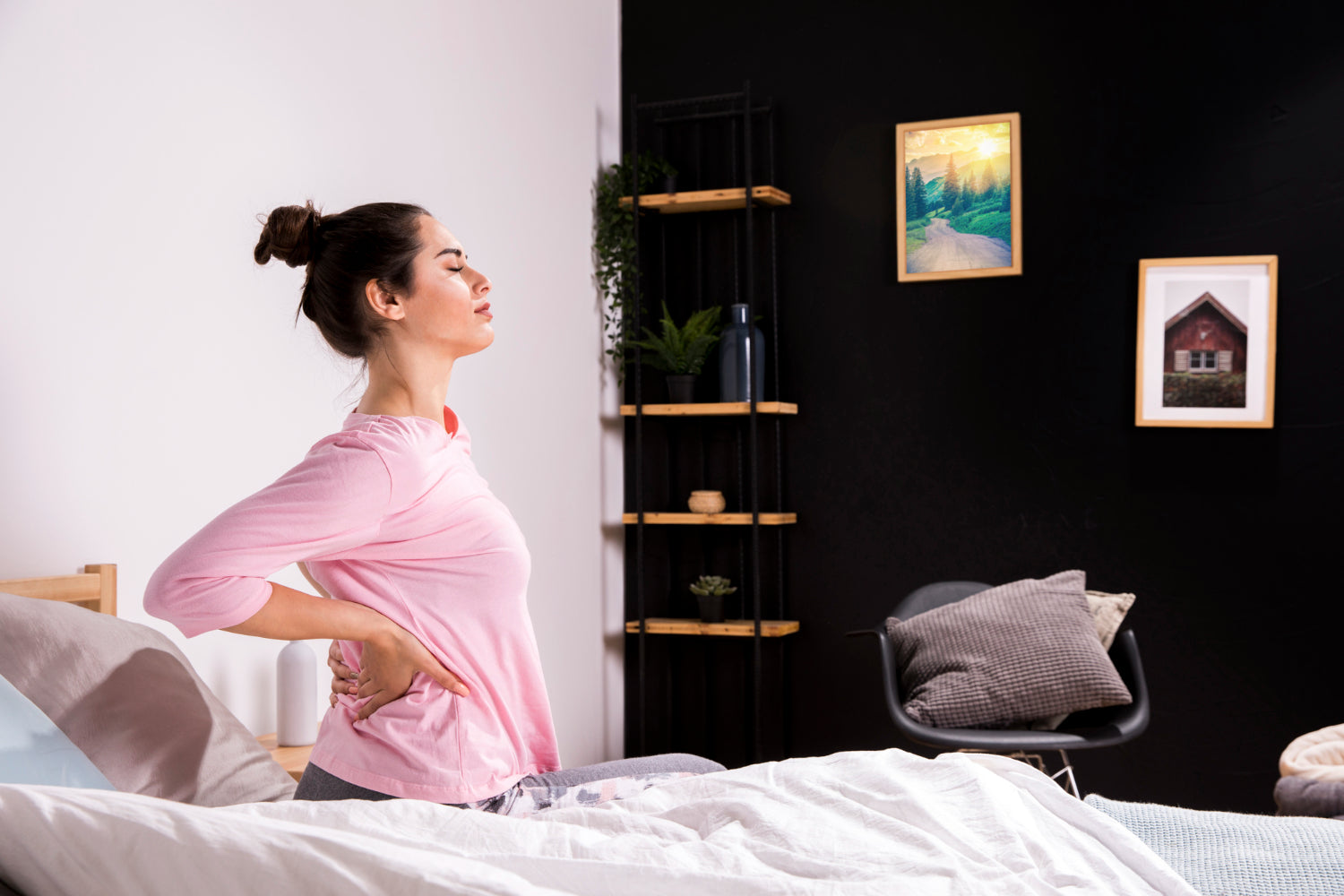What is Hip Bursitis? Injury Overview
Are you worried about hip bursitis?
Read on to find out what causes hip bursitis, how to treat it, and everything else you need to know.

How to Sleep with Piriformis Syndrome
Wondering, "how do I stop piriformis pain at night?" This article lists the best tips to make sleeping more
comfortable when experiencing piriformis syndrome.
Piriformis syndrome is a musculoskeletal condition involving inflammation of the piriformis muscle.
The piriformis muscle is located deep in the glute behind the gluteus maximus. It extends diagonally from the lower back to the upper surface of the femur on each side.
The piriformis muscle plays a critical role in stabilizing the hip joint. It helps the hips rotate and allows the foot and leg to point outwards.
Piriformis syndrome can affect movement, balance, and quality of life. It also commonly impacts sleep.
The Sleep Struggle: Piriformis syndrome can lead to significant discomfort, making finding a comfortable sleep position challenging.
The pain itself from piriformis syndrome can disrupt sleep. When you do not sleep well, it can affect how you perceive and cope with pain. This is why learning how to sleep with piriformis syndrome is so vital.
The Path to Comfort: Proper sleep position and support for pain relief are essential to getting the needed rest. Remember that learning how to sleep with piriformis syndrome may take a little trial and error.
However, there are several things you can do. The article explains the best sleep positions for piriformis syndrome, ways to promote better sleep, and when to see a doctor.
The Best Sleep Positions for Piriformis Syndrome
In some cases, for mild to moderate symptoms of piriformis syndrome, home treatment may be effective. Information on how to treat piriformis syndrome at home includes the following:

Back sleeping - The Best
Most experts agree that sleeping on your back is the piriformis syndrome sleeping position. Sleeping on your back is the best option because it helps distribute pressure evenly and maintains the natural curve of your back. It keeps the spine aligned and in a neutral position.
Key Tip: For the best spinal alignment and support, place one pillow under your head and one under your knees.

Side Sleeping - Next Best
If you cannot sleep on your back, the next best sleep position for piriformis syndrome is side sleeping. But modifying it to prevent pain is helpful if you sleep on your side.
The most common side sleeping position is the fetal position, which involves drawing your knees up towards your chest. However, this leads to an uneven weight distribution and may contribute to pain. Instead of a fetal position, sleep with your legs straight.
Key Tip: If you are a side sleeper, place a pillow between your knees to promote a neutral spine. A body pillow may also help provide additional support and comfort.

Stomach Sleeping - Worst
Stomach sleeping is the worst position for piriformis syndrome and can also contribute to back pain. When you sleep on your stomach, it flattens out the natural curve of your back creating poor sleep posture. This can lead to pressure on your spine and the muscles and joints of the hips and glutes.
Key Tip: It can be challenging to change sleep positions completely. Try to train yourself to sleep on your back. If you sleep on your stomach, use a thin pillow under your head and another under your hips and stomach. This helps prevent the spine from misalignment.
Relaxation Techniques to Promote Sleep
Sleep can be a challenge for everyone. Busy days, work responsibilities, and other daily activities may make it hard to switch gears and sleep at night. If you add in pain from piriformis syndrome, it can be even more difficult to unwind and get to sleep.
Relaxation techniques are an excellent way to transition from a busy day and prepare your body and mind for sleep. Consider some of the following ways to relax:

Gentle Stretching Before Bed
Gentle stretches before bed may help reduce muscle tension and improve flexibility. Research on piriformis syndrome indicates stretching as part of an overall treatment plan.
Do not overstretch; easy stretches are the best before bed. For example, do a cross-body piriformis stretch and a knee-to-chest piriformis stretch. Hold each stretch for about 30 seconds.

Heat Therapy
Applying heat can be a great way to loosen tight muscles before sleeping. Apply a warm compress for about 10 minutes before going to sleep. Avoid falling asleep with a heating pad plugged in, which can lead to a burn.

Practice Relaxation Techniques
Relaxation techniques can help you unwind and slow down. Deep breathing and meditation can help release endorphins, making it easier for you to relax and fall asleep naturally. Practice doing some form of relaxation for about 15 minutes most nights before going to sleep.

TENS Therapy
Transcutaneous electrical nerve stimulation (TENS) targets nerves with low-voltage electricity. TENS stimulates the nerve fibers, which can help block and reduce pain before bed.
Bonus Tips for a Good Night’s Sleep with Piriformis Syndrome
Setting good sleep habits is also critical if you are learning how to sleep with piriformis syndrome. You can do many things to promote an easier time falling and staying asleep. These sleep hygiene habits are helpful even after piriformis syndrome has healed.
Tips for a good night’s sleep with piriformis syndrome include:
Maintain a Regular Sleep Schedule
Try to go to bed and wake up simultaneously every day. A consistent sleep/wake schedule helps set your sleep rhythm and may lead to more restful sleep.
Create a Comfortable Sleep Environment
Your sleep environment helps you feel comfortable and reduces certain factors from interfering with sleep.
Most people sleep best in a cool, quiet, dark room. For instance, drown out noise with ear plugs or a white noise machine. Use blackout curtains to make the room dark. Keep your room cool with a fan or air conditioner.
Limit Caffeine and Alcohol
Alcohol may help you fall asleep, but it interferes with your sleep patterns and may lead to more restlessness. Caffeine can also prevent restful sleep and make it more difficult to fall asleep. Limit caffeine and alcohol in the evening several hours before bed.
Develop a Relaxing Sleep Routine
Develop a routine that helps you unwind before bed. A relaxing routine sends signals to your brain to relax. Whether you take a warm bath, read, or listen to music, do something that helps you wind down.
Consider Limiting Screentime
Just as important as relaxing is avoiding activities that stimulate your brain and interfere with melatonin production. Your brain produces the hormone melatonin, which helps you sleep.
Melatonin production is connected to the time of day, ramping up at night. Using devices that emit light can trick your brain into thinking it's daytime, potentially disrupting melatonin production. Skip the screentime a few hours before bed.
Listen to Your Body
If a recommended sleep position is uncomfortable, listen to your body. For example, place additional support pillows as needed to feel comfortable. Another option is switching out your mattress for something that feels more supportive.
When to See a Doctor
There are many instances when piriformis syndrome is treatable at home. But there are certain times when you should see a doctor. Consider seeing a doctor for piriformis syndrome if you experience the following:
Persistent Pain
If pain continues after trying home treatments, it's best to have it checked by a doctor.
Worsening Symptoms
See a doctor if you develop increased pain or worsening symptoms, such as tingling and numbness. Worsening symptoms may indicate home treatment is not enough to correct the problem.
Difficulty Walking
If you develop difficulty walking, it may be due to a more serious underlying cause. It is best to have a medical professional evaluate your condition to confirm the cause.
Conclusion
Learning to sleep with piriformis syndrome is critical for your comfort and overall well-being. If you do not get the rest you need, it impacts your mood, activity level, and pain management. Your piriformis sleep position is important for managing pain.
Try to sleep on your back. The next best option is side sleeping. If possible, avoid sleeping on your stomach. Pillows placed for support to keep your spine in correct alignment are also helpful.
Implementing some of the strategies above for relaxing before bed is also helpful. The more relaxed you are when you try to sleep, the better.
Remember, good sleep contributes to overall well-being and health. When you do not get the needed rest, your body can also not repair itself. Poor sleep can also cause fatigue, so you may not get the movement your body needs to function optimally. Making sleep a priority is an investment in your overall health.
It's important to talk to a healthcare provider for personalized advice on sleep problems or dealing with piriformis syndrome. Getting professional help can reduce the risk of the problems becoming chronic.
About the Author

MaryAnn DePietro CRT is a licensed respiratory therapist with over 15 years of clinical experience in critical care, emergency medicine, and pulmonary rehabilitation. She is also an American Council on Exercise certified personal trainer and holds specialty certifications in orthopedics, senior fitness, and weight management. MaryAnn has a degree in Rehabilitation from Penn State University and a degree in respiratory therapy.
In addition to her clinical experience, she has written extensively about all things medical, as well as health, fitness, and aging for various websites, magazines, and newspapers.
About Carex Health Brands
Carex is your one-stop shop for home medical equipment and for products that assist caregivers with providing the best possible support and care for their loved ones. Carex Health Brands has been the branded leader in in-home, self-care medical products for over 35 years. Our goal is to improve the lives of our customers by bring them quality products that bring dignity back to their lives. With our three nationally distributed brands, Carex Health Brands serves national, regional and independent food, drug and mass retailers along with wholesalers, distributors and medical dealers.

